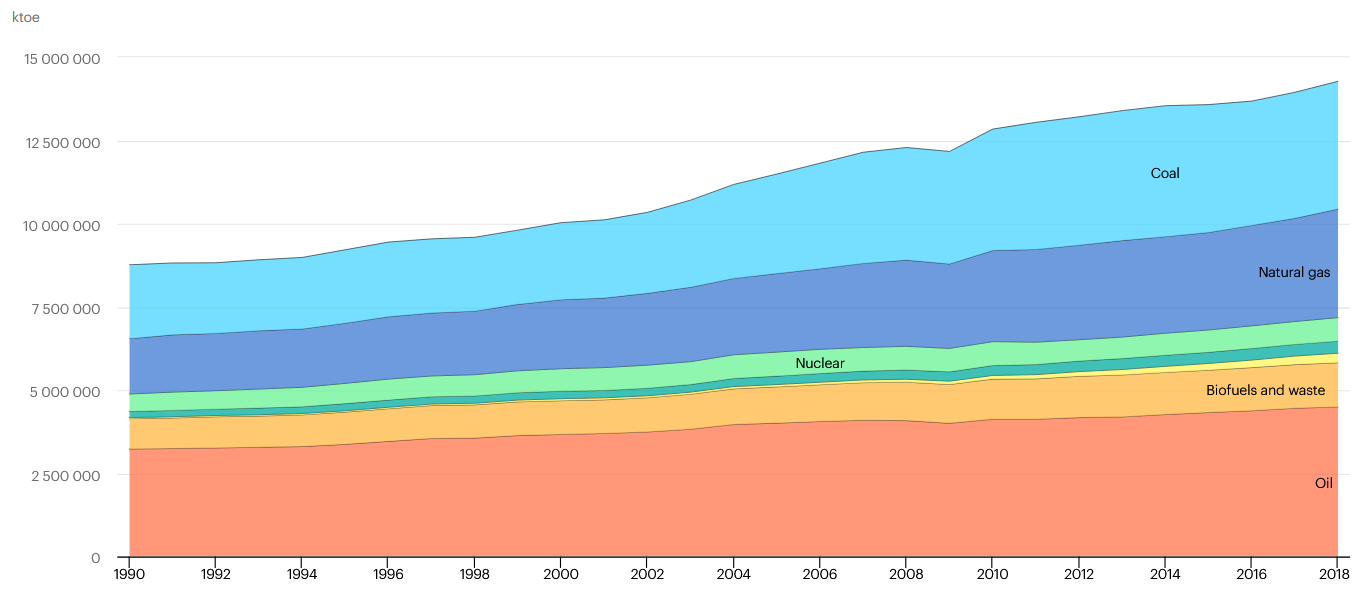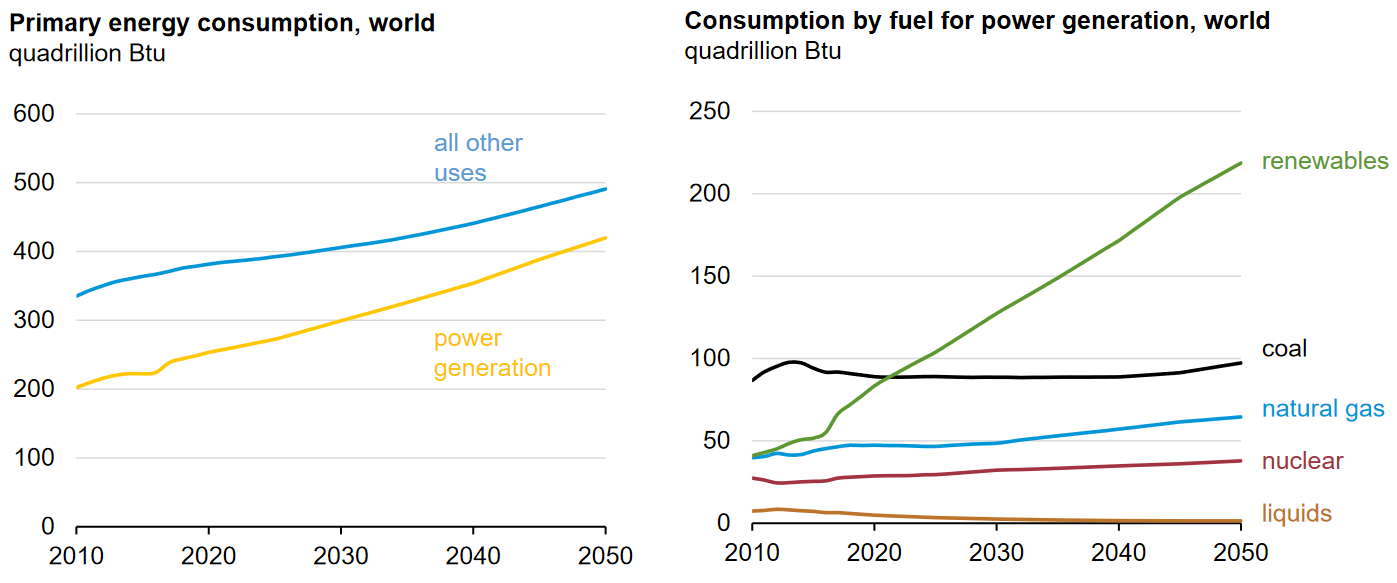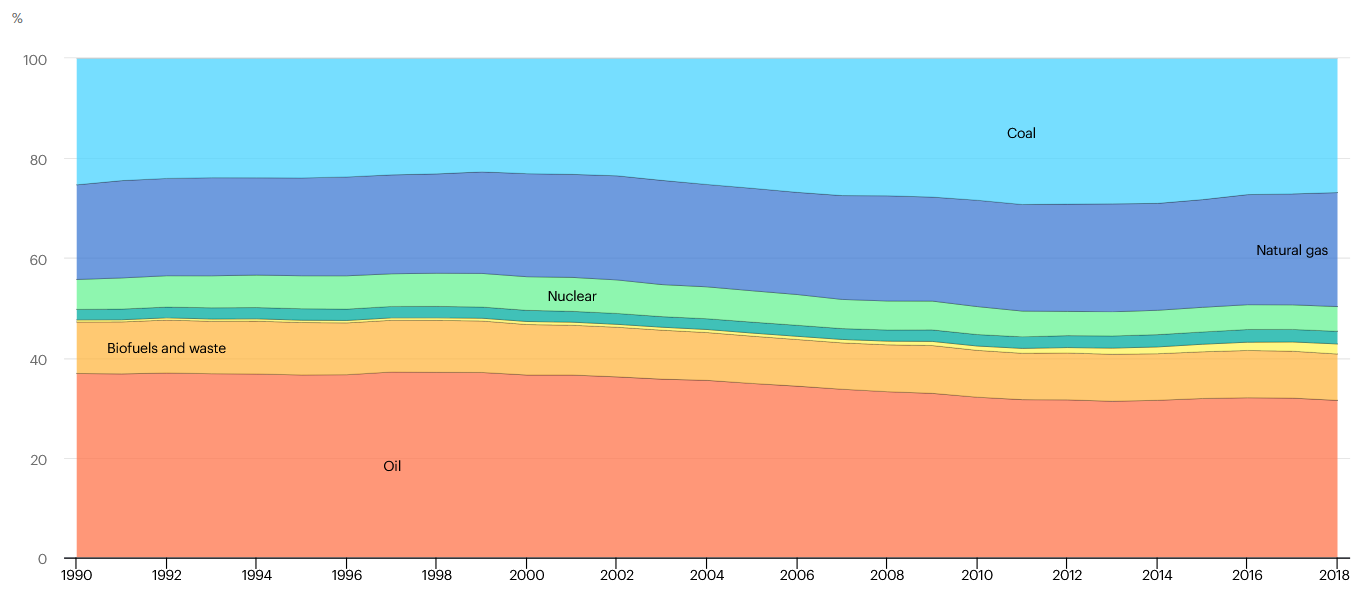The World’s energy supply sources
Before the global pandemic, the World’s energy supply sources followed long-term trends, with new fuels increasing in share and old fuels losing ground. Below, you can see consumption history for the years 1990 to 2018.

Here we can see the role of renewables and natural gas quickly growing.
Three of the world’s largest energy sources
| Source | Future Outlook | Advantages / Disadvantages |
|---|---|---|
| Oil | Over the past four decades, oil has been the world's foremost source of primary energy consumption, and it is expected to remain in that position throughout the projected time frame. Liquids (primarily oil and other petroleum products) are expected to continue to provide the largest share of world's energy consumption over the projected period. | In the transportation sector, in particular, liquid fuels continue to provide most of the energy consumed. Although advances in nonliquids-based transportation technologies are anticipated, they are not enough to offset the rising demand for transportation services worldwide. As a result, oil is projected to retain its predominance in the global energy mix and meet 30% of the total primary energy consumption in 2040. |
| Natural Gas | Worldwide natural gas consumption is projected to increase from 120 trillion cubic feet (Tcf) in 2012 to 203 Tcf in 2040. By energy source, natural gas accounts for the largest increase in world primary energy consumption. Abundant natural gas resources from shale resources and robust production contribute to the strong competitive position of natural gas among other resources. Natural gas remains a key fuel in the electric power sector and in the industrial sector. | It is seen as the desired option for electric power, given its relative efficiency and environmental advantages in comparison with other fossil energy sources.
Natural gas burns more cleanly than either coal or oil, making it a more attractive choice for countries seeking to reduce greenhouse gas emissions. |
| Coal | Coal is the world’s slowest-growing energy source, rising by an average 0.6%/year, from 153 quadrillion Btu in 2012 to 180 quadrillion Btu in 2040. Throughout the projection, the top three coal-consuming countries are China, the United States, and India, which together account for more than 70% of world coal use.
Coal use will continue to increase in developing countries, but in developed or industrialized countries, it will not increase but may slightly decrease. |
Global coal production is projected to increase from 9 billion short tons in 2012 to 10 billion short tons in 2040. Most of the projected growth in world coal production occurs in India, China, and Australia.
Coal remains a vital fuel for world’s electricity markets and is expected to continue to dominate energy markets in developing Asia. |
Energy Consumption and Electricity Projections
According to International Energy Outlook 2019, the strongest growth in electricity generation is projected to occur among the developing, non-OECD nations. Increases in non-OECD electricity generation average 2.5%/year from 2012 to 2040, as rising living standards increase demand for home appliances and electronic devices, as well as for commercial services, including hospitals, schools, office buildings, and shopping malls. In the OECD nations, where infrastructures are more mature and population growth is relatively slow or declining, electric power generation increases by an average of 1.2%/year from 2012 to 2040.

As can be seen from the figures, the role of renewables are expected to change dramatically in the coming years. What a transition!
Nuclear Power
Worldwide, electricity generation from nuclear power is projected to remain largely unchanged into 2040.
According to International Energy Outlook projections by US Department of Energy (US DOE), there is still considerable uncertainty about the future of nuclear power, and a number of issues could slow the development of new nuclear power plants. Issues related to plant safety, radioactive waste disposal, and proliferation of nuclear materials continue to raise public concerns in many countries and may hinder plans for new installations. Although the long-term implications of the disaster at Japan's Fukushima Daiichi nuclear power plant for world nuclear power development are unknown, Germany, Switzerland, and Italy have already announced plans to phase out or cancel all their existing and future reactors. In contrast, developing Asia is poised for a robust expansion of nuclear generation. Most of the increase is by China's addition of 139 gigawatts (GW) of nuclear capacity from 2012 to 2040.

In a nuclear plant, heat is produced by nuclear fission (splitting of an atom's nucleus into many new atoms) inside uranium fuel. As a result of fission, heat energy is released and the steam spins a turbine generator to produce electricity.
Renewables
Sizable growth in the world’s consumption of renewable energy resources is projected over the next 25 years. Much of the projected growth in renewable generation is expected to result from the completion of solar installations all throughout the world. Dramatic reductions in the cost of solar panels has led to this source being one of the cheapest forms of electric power generation as of 2020. In 2020, 90 % of all new electric power generation installations were renewable across the globe.

In hydroelectricity, mechanical energy from the water being pulled downward by gravity is converted to electrical energy. More specifically, a hydroelectric generator directs the flow of water through a turbine, which extracts the kinetic energy from the movement of the water and turns it into electricity through the rotation of electrical generators. Hydropower is the largest single renewable electricity source today, providing 16% of world electricity at competitive prices. It dominates the electricity mix in several countries, developed, emerging, or developing. However, wind and solar are quickly catching up.

